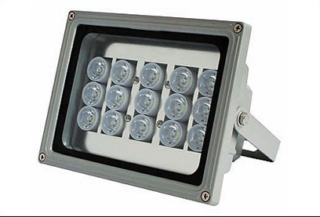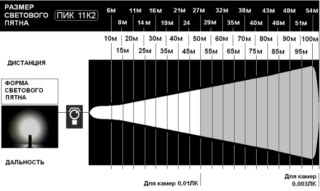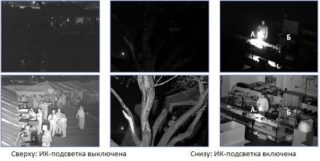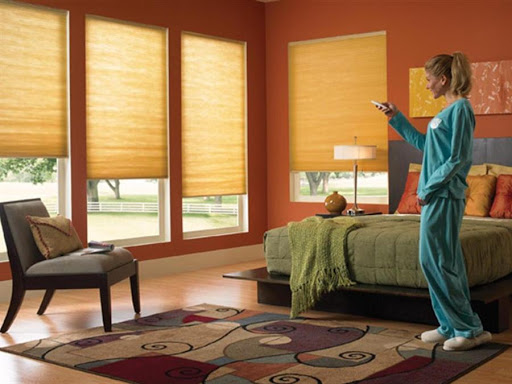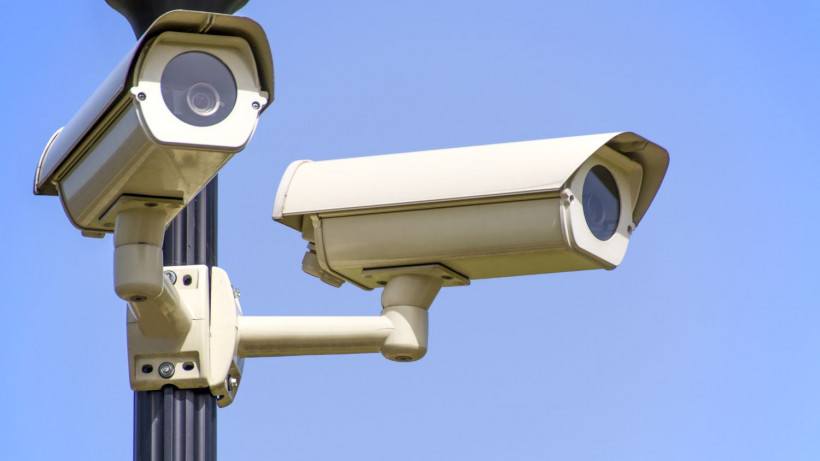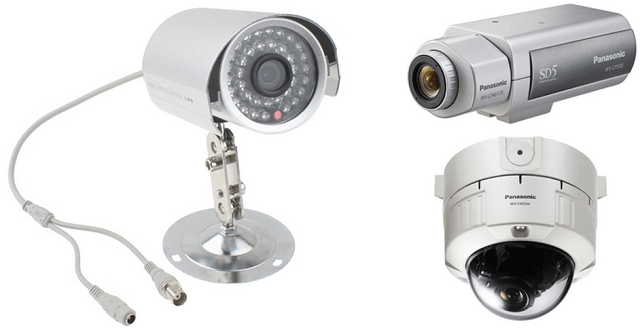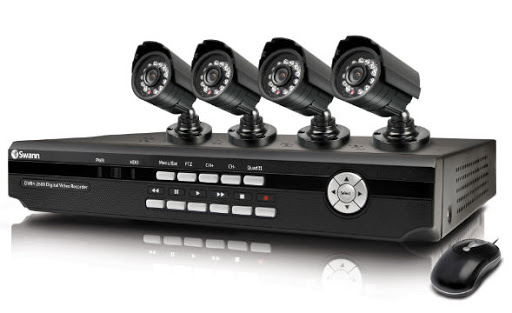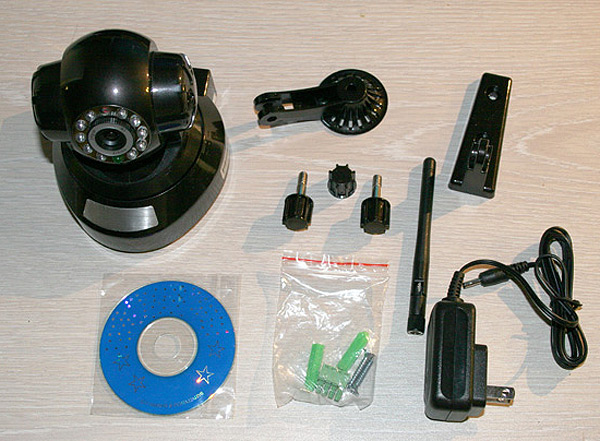A standard video camera works well only during the day, with sufficient lighting. Sensitivity of the sensors is limited, so observation is impossible in the dark. IR illumination is a technical solution that allows a video camera to work in the infrared spectrum.
Definition of IR illumination and its need

When sunlight hits the lens, some of the radiation is absorbed and some is reflected. The sensors pick up the reflected radiation and register it. Then in the processing module the signal is formatted in digital and in this form is recorded or transmitted to the device. However, this system has drawbacks: when the light level gets too low, the difference between surfaces and objects is too small for the sensors to pick up. In the dark, the device is helpless.
Infrared camera illumination solves this problem. The device emits infrared radiation. It is invisible to human eyes, but sensors pick up the reflected signal and fix it, forming an image in the usual way.
The quality of the "picture" is low: the image is monochrome, "flat", but quite clear, since the temperature of living and inanimate objects differs quite strongly.
IR illumination is an energy-consuming element. Cameras with built-in illumination require an additional power supply.
Important parameters and characteristics
The basis of the devices is infrared LEDs. They differ in purpose, form factor, radiation power. The range of waves that they emit is very large - 0.75-2000 microns, therefore, instead of the actual technical characteristics, only those that relate directly to their properties are used to describe the elements:
- power per unit of time - or the amount of current supplied through the element;
- radiation area is an additional characteristic;
- luminous flux intensity - measured within the solid or spatial angle in W / sr;
- range of radiated waves;
- rated forward current and maximum impulse current;
- voltage drop value;
- reverse voltage magnitude.
Since infrared LEDs do not always work in a constant mode, the parameters in the passport indicate the parameters in continuous and pulsed modes.
Varieties of IR illumination

IR illumination for a home security camera is very diverse. Devices are classified by design, range, the nature of the optical system and other features.
By external parameters
IR illumination can be part of the device itself or it can be a stand-alone device. The first option is called embedded, the second is called external.
- Built-in is located in the camcorder body. It is compact, can be adjusted simultaneously with the main device, does not give specific scarlet glare. However, the device is low-power, the probability of exposure is very high. The disadvantage is the high false alarm rate. Infrared radiation is perfectly felt by insects and tend to get closer to the lens. At this distance, the sensors react to bugs and butterflies in the same way as to large thermal objects.
LED IR Spotlight External option - IR illuminator. A separate device to be installed and configured. This requires experience and time. But the searchlight can be selected in terms of power, range, sensitivity. Together with the camera, it will cost less than the model with a built-in IR module. When installing the device, pay attention to the ability to remove heat: a powerful floodlight can overheat.
The floodlight acts at a greater distance in any case than the built-in model.
By scope
The devices operate in different modes. On this basis, 3 main groups are distinguished:
- Constant IR illumination - the device turns on when the sensitive photocell receives a signal. The settings are set at the first start-up and do not change. Models are available for both outdoor and indoor use.
- Pulsed - generate directional radiation of a certain power and frequency. The parameters are adjustable. The device uses less energy and works longer.
- Perimeter - covers the maximum area - up to 200 sq. m. Install the searchlight so that it covers the protected area and part of the adjacent territory.
When choosing, take into account the angle of view of the video camera. A backlight device should have a smaller amount than a recording device, since the edges of the frame on the screen often remain invisible.
By wavelength
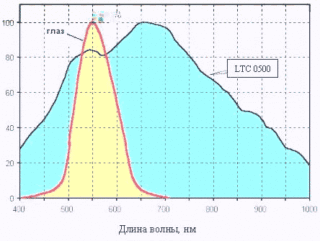
- 720-750 nm - waves of this length are in the visible part of the spectrum. Searchlights operating in this range are used for the most distant illumination - perimeter protection, monitoring a large area. Up close, the spotlight is visible due to the background red glow.
- 800 nm is also visible radiation, but hardly noticeable.
- 860–880 nm - Allows the camera to operate at short distances. However, the radiation is completely invisible to the human eye. This option is more suitable for indoor video surveillance.
- 920-950 nm - floodlights of the same category, but designed for work at short distances.
The emission values are given in the product data sheet.
By the form of execution
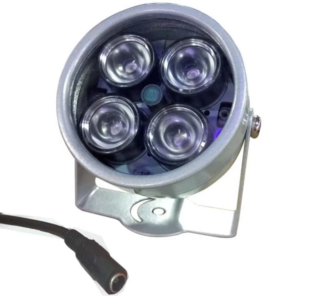
Infrared illumination for cameras by the type of radiation source is divided into 2 types:
- LED - IR radiation generates semiconductor elements. Such IR illumination consumes less electricity, is not afraid of the cold, and is very durable. However, a searchlight based on ice elements is more expensive.
- Lamp - the source of radiation is an infrared lamp. There are 2 types of spotlights. There are models that continuously emit in the infrared range. Such lamps are coated with a special compound that transmits light only in the thermal range. Another option is a model with a light filter. It transmits radiation with wavelengths above 950 nm. A spotlight with a filter is a high power consumption.
Lamp emitters are much cheaper. However, these lamps have to be changed frequently.
Scope of application
Long-wave infrared illumination is required in the following cases:
- In low light conditions, IR illumination allows you to correct the resulting image. Additional radiation allows you to highlight shadows, see more details in supermarkets.
- For a covert video surveillance system, IR illumination is required. In the dark, such a large thermal object as a person is perfectly visible, which makes it possible to prevent a crime.
- Install IR illumination to increase the throughput of the video surveillance system. It improves the image, takes less time to process it, and the quality of the recording remains high.
- The device improves the image obtained from megapixel cameras.
For the IR illuminator to be as useful as possible, it is necessary to install a video camera that is sensitive to radiation in the thermal range.
Features of Backlit Cameras
- Neither the built-in model nor the spotlight increase the range of the video surveillance. It only improves image quality at night.
- The main selection criterion is the range. A powerful street spotlight should not be installed in an apartment or on a staircase.
- Angle of view - even more important indoors than range. However, this parameter must correspond to the angle of view of the video camera;
- When installing an IR illuminator of any power, you will need to install an additional power supply.
You can make the backlight for video surveillance yourself. However, this option is only suitable for a home system.
How far does the IR illuminator illuminate?
It is easier for the consumer to choose a model, focusing on the range of the device specified in the characteristics. There are 3 groups:
- A short-range floodlight - the radius is limited to 10 m. Devices are mounted in video peepholes, in intercoms, on staircases, in apartments, in emergency lighting systems.
- A medium-range device - for 20-60 m. It is used to illuminate the area near the house, cinema halls.
- Long-range - the radius reaches 350 m. Searchlights are installed at stadiums, guarded warehouses, squares, and the territory of closed-type cottage settlements.
The larger the range of the device, the smaller the viewing angle.
Advantages and disadvantages
- Infrared illumination provides observation of the room, house and the territory of the whole area at night.
- Corrects image quality in low light conditions, improves detail.
- The backlight reduces power consumption. Illumination of the courtyard with powerful floodlights is much more expensive than installing infrared lamps and observing in infrared radiation.
- LED devices last a long time.
There are also disadvantages:
- the image is only black and white, regardless of which camera is installed;
- in a lamp spotlight, you often have to change bulbs;
- Diffuser glasses need to be cleaned frequently.
The combination of an IR video camera and a motion sensor is a good protection option. The devices are used to create a security system both inside the home and on the street.

